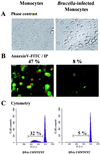In vitro Brucella suis infection prevents the programmed cell death of human monocytic cells
- PMID: 10603407
- PMCID: PMC97140
- DOI: 10.1128/IAI.68.1.342-351.2000
In vitro Brucella suis infection prevents the programmed cell death of human monocytic cells
Abstract
During the complex interaction between an infectious agent and a host organism, the pathogen can interfere with the host cell's programmed death to its own benefit. Induction or prevention of host cell apoptosis appears to be a critical step for determining the infection outcome. Members of the gram-negative bacterial genus Brucella are intracellular pathogens which preferentially invade monocytic cells and develop within these cells. We investigated the effect of Brucella suis infection on apoptosis of human monocytic phagocytes. The present study provides evidence that Brucella infection inhibited spontaneously occurring apoptosis in human monocytes. Prevention of monocyte apoptosis was not mediated by Brucella lipopolysaccharide and required bacterial survival within infected cells. Both invaded and noninvaded cells were protected, indicating that soluble mediators released during infection were involved in the phenomenon. Analysis of Brucella-infected monocytes revealed specific overexpression of the A1 gene, a member of the bcl-2 family implicated in the survival of hematopoietic cells. Brucella infection also rendered macrophage-like cells resistant to Fas ligand- or gamma interferon-induced apoptosis, suggesting that Brucella infection protected host cells from several cytotoxic processes occurring at different steps of the immune response. The present data clearly show that Brucella suis modulated the monocyte/macrophage's apoptotic response to the advantage of the pathogen, thus preventing host cell elimination. This might represent a strategy for Brucella development in infected hosts.
Figures






Similar articles
-
Establishment of Chronic Infection: Brucella's Stealth Strategy.Front Cell Infect Microbiol. 2016 Mar 15;6:30. doi: 10.3389/fcimb.2016.00030. eCollection 2016. Front Cell Infect Microbiol. 2016. PMID: 27014640 Free PMC article. Review.
-
The innate immune response against Brucella in humans.Vet Microbiol. 2002 Dec 20;90(1-4):383-94. doi: 10.1016/s0378-1135(02)00223-7. Vet Microbiol. 2002. PMID: 12414158 Review.
-
V gamma 9V delta 2 T cells impair intracellular multiplication of Brucella suis in autologous monocytes through soluble factor release and contact-dependent cytotoxic effect.J Immunol. 2000 Dec 15;165(12):7133-9. doi: 10.4049/jimmunol.165.12.7133. J Immunol. 2000. PMID: 11120844
-
Vgamma9Vdelta2 T cells use a combination of mechanisms to limit the spread of the pathogenic bacteria Brucella.J Leukoc Biol. 2005 May;77(5):652-60. doi: 10.1189/jlb.0704433. Epub 2005 Jan 24. J Leukoc Biol. 2005. PMID: 15668339
-
Proinflammatory response of human osteoblastic cell lines and osteoblast-monocyte interaction upon infection with Brucella spp.Infect Immun. 2009 Mar;77(3):984-95. doi: 10.1128/IAI.01259-08. Epub 2008 Dec 22. Infect Immun. 2009. PMID: 19103778 Free PMC article.
Cited by
-
The analysis of the intramacrophagic virulome of Brucella suis deciphers the environment encountered by the pathogen inside the macrophage host cell.Proc Natl Acad Sci U S A. 2002 Nov 26;99(24):15711-6. doi: 10.1073/pnas.232454299. Epub 2002 Nov 18. Proc Natl Acad Sci U S A. 2002. PMID: 12438693 Free PMC article.
-
Establishment of Chronic Infection: Brucella's Stealth Strategy.Front Cell Infect Microbiol. 2016 Mar 15;6:30. doi: 10.3389/fcimb.2016.00030. eCollection 2016. Front Cell Infect Microbiol. 2016. PMID: 27014640 Free PMC article. Review.
-
Coxiella burnetii inhibits apoptosis in human THP-1 cells and monkey primary alveolar macrophages.Infect Immun. 2007 Sep;75(9):4263-71. doi: 10.1128/IAI.00594-07. Epub 2007 Jul 2. Infect Immun. 2007. PMID: 17606599 Free PMC article.
-
Brucellosis in renal transplant recipients: a comparative review of 5 cases.BMJ Case Rep. 2018 Jul 30;2018:bcr2018225865. doi: 10.1136/bcr-2018-225865. BMJ Case Rep. 2018. PMID: 30065056 Free PMC article. Review.
-
Brucella abortus rough mutants are cytopathic for macrophages in culture.Infect Immun. 2004 Jan;72(1):440-50. doi: 10.1128/IAI.72.1.440-450.2004. Infect Immun. 2004. PMID: 14688125 Free PMC article.
References
-
- Adachi S, Cross A R, Babior B M, Gottlieb R A. Bcl-2 and the outer mitochondrial membrane in the inactivation of cytochrome c during Fas-mediated apoptosis. J Biol Chem. 1997;272:21878–21882. - PubMed
-
- Behr-Perst S I, Munk M E, Schaberg T, Ulrichs T, Schulz R J, Kaufmann S H E. Phenotypically activated γδ T lymphocytes in the peripheral blood of patients with tuberculosis. J Infect Dis. 1999;180:141–149. - PubMed
-
- Campbell G A, Adams L G, Sowa B A. Mechanisms of binding of Brucella abortus to mononuclear phagocytes from cows naturally resistant or susceptible to brucellosis. Vet Immunol Immunopathol. 1994;41:295–306. - PubMed
-
- Caron E. Thesis. Montpellier, France: Université de Montpellier II; 1994.
Publication types
MeSH terms
Substances
LinkOut - more resources
Full Text Sources
Research Materials
Miscellaneous

